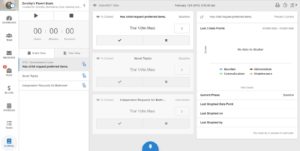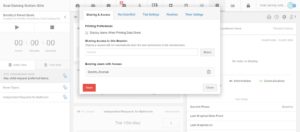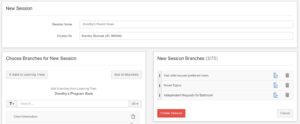By Lauren Corbett
CentralReach Clinical Implementation Coordinator, BCBA
If you work in the field of Applied Behavior Analysis (ABA), you have spent the additional hours putting in the work to provide superior outcomes. The hours outside of school, ABA therapy or social skills groups. The time spent away from job training and life skills courses with the parents, caregivers, and siblings of the client. You go the extra mile so the client can work on generalizing or maintaining skills taught in other environments, and you invest extra time teaching colors, shaping behaviors, or patiently sitting on a tiny stool toilet training.
“So why the need for collaborative and definitive goals for caregivers? The answer is simple: because they are the ones who will provide the countless additional hours of support for our client’s entire lives.”
Involving parents and caregivers in the planning, generalization, and maintenance of skills has been widely implemented as a fundamental standard for an individual’s comprehensive autism treatment. Research has shown that parental participation in the generalization of goals has a positive impact on overall treatment (Ozonoff & Cathcart, 1998).
Here are two elements to consider when creating parent goals:
1. Teach the Teacher
Imagine you walk into a cabinetry shop and while admiring the craftsmanship, the master carpenter declares you his new carpenter. Suddenly, you feel this void of knowledge and apprehension of the future because you have no idea how to frame or panel, you’ve never heard of a speed square, and you certainly don’t know how to use a worm drive saw. But you don’t have a choice — carpentry is now a part of your life and you’ll have to navigate the jargon, learn the tools and invest time into meeting with masters of the field to stay afloat.
On a larger scale, parents of children recently diagnosed with autism may be going through something similar — a new world to navigate, terms to learn, specialists to meet and a foreign system they will need to understand quickly to know what is best for their child. Providers have a responsibility to make goals not only concise and understandable, but also meaningful to the family unit who will implement them.
2. Generalization and Maintenance
A parent teaches their 15-year-old how to drive in a vacant parking lot. The teenager learns how to change gears, accelerate, break, use a blinker and turn the wheel. They practice every day for six months, but when the time comes for them to take their driver’s test and navigate variables such as traffic signs, vehicles on the road, intersections, and pedestrians, they fail to generalize the skills they learned in the parking lot.
ABA providers have a responsibility to ensure client skills and concepts learned in a controlled, therapeutic environment are generalized to other settings. Additionally, if there is an absence of parent involvement, it can create a “disconnect between the treatment room and what goes on in the child’s home” (Bennett, 2012). Parents are the best resource for generalization because they are the ones helping the client navigate their day-to-day life.
Current State of Parent Goals and Insurance
As ABA and autism treatment evolves, payor standards and guidelines evolve as well. Working with multiple insurances, keeping track of shifting standards, and reporting accordingly to payors can be taxing on providers. Today, most insurances have guidelines for how to write and track goals specific to parent participation. The following is a sample parent goal requirement taken from an insurance company:
“Family goals and objectives are selected jointly by the authorized ABA supervisor and the parent(s)/Caregiver(s). Family goals should include mastered goals that will be targeted for generalization. Generalization goals should be specific and measurable.” – Tricare
Fortunately, CentralReach’s data collection platform (Learn) can ease the stressors of tracking and reporting on parent goals through a feature called “Learning Trees.” Below is an example of how to set up a parent goal section within a client’s learning tree with similar goals, charts, and data points recorded by parents.
How to Get Started
Before you begin, plan to track the goal via access in CentralReach’s Learn Module to the cumulative graph which provides a visual representation of when goals are mastered and how many at a time.
- Add a parent goal section to your client’s Learning Tree.
- Next, create a data sheet specifically for the parents! You’ll set this up so families can find it in the Client Portal and can access it electronically at any time.
- Share the session with the Client Portal account.
- The parent can then access the goals by logging into the Client Portal.
- Parents will now have access to a live electronic data sheet they can utilize to record their implementation of goals.
About the Author
Lauren Corbett holds a Master’s of Science degree from California State University, Fresno, and is a Board Certified Behavior Analyst. Over the past 15 years, Lauren has worked in schools, homes, and centers providing direct intervention, supervision and consultative services for children diagnosed with Autism. Lauren also enjoys volunteering as a Guardian at Litem, applying her behavior analytic experience to at-risk children and their families. At CentralReach, Lauren is a Clinical Implementation Coordinator – ABA Subject Matter Expert and works with clients to plan, execute, and oversee the implementation of CentralReach in their day-to-day clinical practice.










